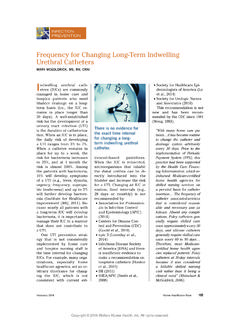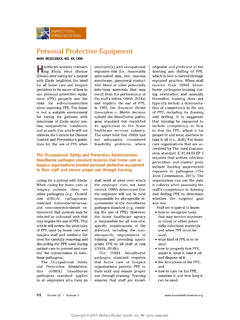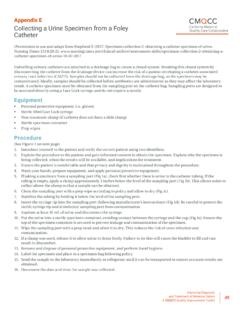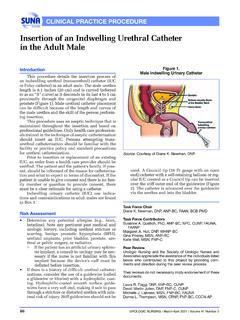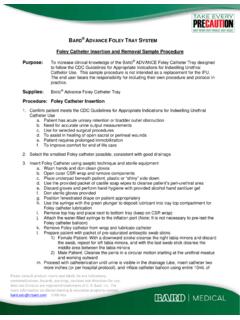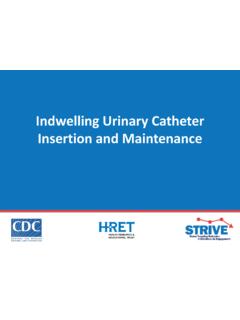Transcription of Frequency for Changing Long-Term Indwelling Urethral …
1 INFECTION PREVENTIONF ebruary 2016 Home Healthcare Now 105denced-based guidelines. When the IUC is reinserted, microorganisms that inhabit the distal urethra can be di-rectly introduced into the bladder and increase the risk for a UTI. Changing an IUC at routine, fixed intervals ( , 28 days or monthly) is not recommended by: Association for Profession-als in Infection Control and Epidemiology [APIC] (2014) Centers for Disease Con-trol and Prevention (CDC) (Gould et al., 2010) epic 3 (Loveday et al., 2014) Infectious Disease Society of America [IDSA] and there is insufficient evidence to make a recommendation on Long-Term catheters (Hooton et al., 2010) IHI (2011) SHEA/APIC (Smith et al., 2008) Society for Healthcare Epi-demiologists of America (Lo et al., 2014) Society for Urologic Nurses and Associates (2010)This recommendation is not new and has been recom-mended by the CDC since 1981 (Wong, 1983).
2 With many home care has become routine to change the catheter and drainage system arbitrarily every 30 days. Prior to the implementation of Periodic Payment System (PPS), this practice had been supported by the Health Care Financ-ing Administration, which re-imbursed Medicare-certified home health agencies for skilled nursing services on a per-visit basis for catheter The Frequency of catheter associated-services that is considered reason-able and necessary was as follows: Absent any compli-cations, Foley catheters gen-erally require skilled care once approximately every 30 days, and silicone catheters generally require skilled care once every 60 to 90 Therefore, most Medicare-certified home health agen-cies replaced patients Foley catheters at 30-day intervals because it was considered a billable skilled nursing visit rather than it being a clinical need (Rhinehart & McGoldrick, 2006).
3 Frequency for Changing Long-Term Indwelling Urethral CathetersMARY MCGOLDRICK, MS, RN, CRNII ndwelling Urethral cath-eters (IUCs) are commonly managed in home care and hospice patients who need bladder drainage on a Long-Term basis ( , the IUC re-mains in place longer than 30 days). A well-established risk for the development of a urinary tract infection (UTI) is the duration of catheteriza-tion. When an IUC is in place, the daily risk of developing a UTI ranges from 3% to 7%. When a catheter remains in place for up to a week, the risk for bacteriuria increases to 25%, and at 1 month the risk is almost 100%. Among the patients with bacteriuria, 10% will develop symptoms of a UTI ( , fever, dysuria, urgency, Frequency , suprapu-bic tenderness) and up to 3% will further develop bactere-mia (Institute for Healthcare Improvement [IHI], 2011). Be-cause nearly all patients with a Long-Term IUC will develop bacteriuria, it is important to manage their IUC in a manner that does not contribute to a UTI prevention strat-egy that is not consistently implemented by home care and hospice nursing staff is the time interval for Changing IUCs.
4 For example, many orga-nizations, especially home healthcare agencies, set an ar-bitrary timeframe for chang-ing the IUC, which is not consistent with current evi-There is no evidence for the exact time interval for Changing a Long-Term Indwelling Urethral 2016 Wolters Kluwer Health, Inc. All rights Volume 34 | Number 2 an IUC is still considered a Medicare-covered service, but the home healthcare agency is no longer reimbursed on a per-visit basis, yet the prac-tice of replacing the catheter every 28 to 30 days has contin-ued. There is no evidence for the exact time interval for Changing a Long-Term IUC. IUCs should be changed according to the:1. Physician ordered time in-terval ( , based on the patient s usual pattern of catheter care, if any, rather than waiting for complica-tions to occur);2.
5 Patient s clinical condition and nursing staff s evalua-tion of catheter -associated problems and complica-tions, such as leakage, obstruction from encrusta-tions, and infection;3. Dwell time prior to obtaining a urine specimen;4. Incidence of a break in asep-tic technique during cath-eter insertion; and5. Manufacturer s instructions for use, if an infection occurs fre-quently or obstruction is com-mon, the IUC should be changed more often (Tenke et al., 2008).The IDSA (Hooton et al., 2010) recommends that cath-eters be changed prior to the collection of a urine specimen for a suspected catheter -asso-ciated urinary tract infection (CAUTI) if the IUC has been in place for 2 weeks or longer at the onset of the CAUTI (and the IUC is still needed). After an Indwelling catheter has been in place for some time, biofilms develop and as a re-sult, a urine culture obtained from a patient whose indwell -ing catheter has a biofilm may not accurately reflect the bac-teriology of bladder urine (McGoldrick, 2015).
6 Another recommended indi-cation for catheter replacement is when the closed system is compromised (Gould et al., 2010). Some ambulatory home care patients transfer to a leg bag for urine containment dur-ing the day, which results in a breach of the closed urinary drainage system. When possi-ble, breaching the closed uri-nary system is to be IUC should remain in place only as long as the reason for insertion is still present. However, managing patients Long-Term IUCs will continue to be a routine service provided by home care and hospice nurses and we need to base our patient care practices on evi-denced-based data whenever possible. Mary McGoldrick, MS, RN, CRNI, is a Home Care and Hospice Consultant, Home Health Systems, Inc., Saint Simons Island, author declares no conflicts of for correspondence: Mary McGold-rick, MS, RN, CRNI, Box 21704, Saint Simons Island, GA 31522 for Professionals in Infection Control and Epidemiology.
7 (2014). Guide to preventing catheter -associated urinary tract infections. #CatheterGould, C. V., Umscheid, C. A., Agarwal, R. K., Kuntz, G., Pegues, D. A., & the Healthcare Infection Control Practices Advisory Committee. (2010). Guideline for prevention of catheter -associated urinary tract infections 2009. Infection Control and Hospital Epidemiology, 31(4), 319 , T. M., Bradley, S. F., Cardenas, D. D., Colgan, R., Geerlings, S. E., Rice, J. C., .., Nicolle, L. E. (2010). Diagno-sis, prevention and treatment of cath-eter-associated urinary tract infections in adults: 2009 international practice guidelines. Clinical Infectious Diseases, 50, 625 for Healthcare Improvement. (2011). How-to Guide: Prevent catheter -Associated Urinary Tract Infections. Cambridge, MA. Retrieved from , E., Nicolle, L. E., Coffin, S. E., Gould, G., Maragakis, L. L., Meddings, J., .., Yokoe, D.
8 S. (2014). Strategies to pre-vent catheter -associated urinary tract infections in acute care hospitals: 2014 update. Infection Control and Hospital Epidemiology, 35(5), 464 , H. P., Wilson, J. A., Pratt, R. J., Golsorkhi, M., Tingle, A., Bak, A., .., Wilcox, M. (2014). epic3: National evidence-based guidelines for prevent-ing healthcare-associated infections in NHS hospitals in England. The Journal of Hospital Infection, 86(Suppl. 1), S1 , M. (2015). Urine specimen col-lection and transport. Home Healthcare Now, 33(5), 284 , E., & McGoldrick, M. (2006). Infection Control in Home Care and Hos-pice (2nd ed., p. 27). Boston, MA: Jones and , P. W., Bennett, G., Bradley, S., Drinka, P., Lautenbach, E., Marx, J., .., Stevenson, K. (2008). SHEA/APIC Guideline: Infection prevention and con-trol in the Long-Term care facility. Ameri-can Journal of Infection Control, 36(7), 504 of Urologic Nurses and Associates.
9 (2010). Clinical practice guidelines. Pre-vention & control of catheter - associated urinary tract infection (CAUTI). Retrieved from , P., Kovacs, B., Bjerklund Johan-sen. T. E., Matsumoto, T., Tambyah, P. A., & Naber, K. G. (2008). European and Asian guidelines on management and prevention of catheter -associated uri-nary tract infections. International Jour-nal of Antimicrobial Agents, 31(Suppl. 1), S68 , E. S. (1983). Guideline for preven-tion of catheter -associated urinary tract infections. American Journal of Infection Control, 11(1), 28 IUC should remain in place only as long as the reason for insertion is still 2016 Wolters Kluwer Health, Inc. All rights reserved.
